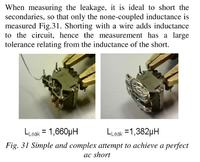T
treez
Guest
Hello,
For a transformer in LTspice, can you confirm that the k factor (coupling factor) gives the leakage inductance by this formula….(1-k^2)*L(pri)?
Also, that this leakage inductance value is that inductance value that you would measure if you shorted the secondary and measured the inductance at the primary terminals?
That is (1-k^2)*L(pri) = Llkp + Llkp//L(pri)
Where:
Llkp = Leakage term in the primary of the transformer
For a transformer in LTspice, can you confirm that the k factor (coupling factor) gives the leakage inductance by this formula….(1-k^2)*L(pri)?
Also, that this leakage inductance value is that inductance value that you would measure if you shorted the secondary and measured the inductance at the primary terminals?
That is (1-k^2)*L(pri) = Llkp + Llkp//L(pri)
Where:
Llkp = Leakage term in the primary of the transformer


